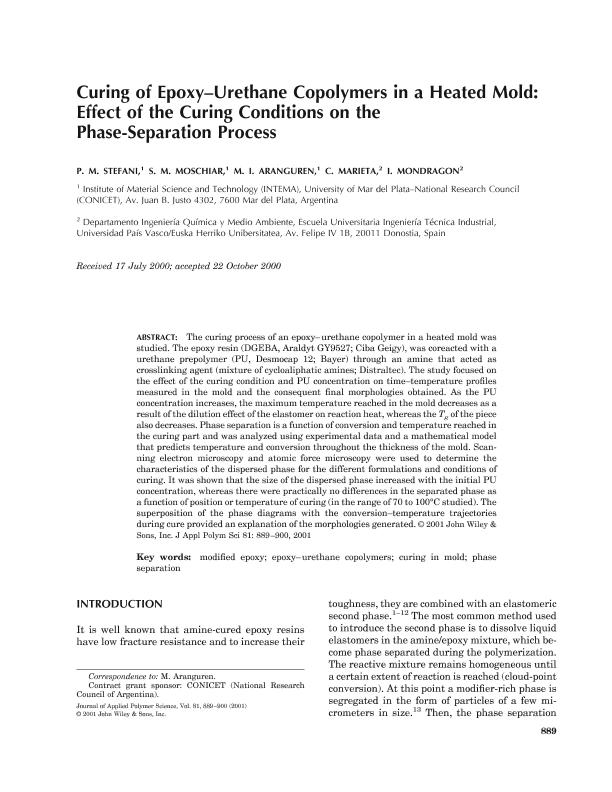Artículo
Curing of epoxy-urethane copolymers in a heated mold: Effect of the curing conditions on the phase-separation process
Stefani, Pablo Marcelo ; Moschiar, Stella Maris
; Moschiar, Stella Maris ; Aranguren, Mirta Ines
; Aranguren, Mirta Ines ; Marieta, C.; Mondragon, I.
; Marieta, C.; Mondragon, I.
 ; Moschiar, Stella Maris
; Moschiar, Stella Maris ; Aranguren, Mirta Ines
; Aranguren, Mirta Ines ; Marieta, C.; Mondragon, I.
; Marieta, C.; Mondragon, I.
Fecha de publicación:
07/2001
Editorial:
John Wiley & Sons Inc
Revista:
Journal of Applied Polymer Science
ISSN:
0021-8995
Idioma:
Inglés
Tipo de recurso:
Artículo publicado
Clasificación temática:
Resumen
The curing process of an epoxy-urethane copolymer in a heated mold was studied. The epoxy resin (DGEBA, Araldyt GY9527; Ciba Geigy), was coreacted with a urethane prepolymer (PU, Desmocap 12; Bayer) through an amine that acted as crosslinking agent (mixture of cycloaliphatic amines; Distraltec). The study focused on the effect of the curing condition and PU concentration on time-temperature profiles measured in the mold and the consequent final morphologies obtained. As the PU concentration increases, the maximum temperature reached in the mold decreases as a result of the dilution effect of the elastomer on reaction heat, whereas the Tg of the piece also decreases. Phase separation is a function of conversion and temperature reached in the curing part and was analyzed using experimental data and a mathematical model that predicts temperature and conversion throughout the thickness of the mold. Scanning electron microscopy and atomic force microscopy were used to determine the characteristics of the dispersed phase for the different formulations and conditions of curing. It was shown that the size of the dispersed phase increased with the initial PU concentration, whereas there were practically no differences in the separated phase as a function of position or temperature of curing (in the range of 70 to 100°C studied). The superposition of the phase diagrams with the conversion-temperature trajectories during cure provided an explanation of the morphologies generated.
Palabras clave:
Curing in Mold
,
Epoxy-Urethane Copolymers
,
Modified Epoxy
,
Phase Separation
Archivos asociados
Licencia
Identificadores
Colecciones
Articulos(INTEMA)
Articulos de INST.DE INV.EN CIENCIA Y TECNOL.MATERIALES (I)
Articulos de INST.DE INV.EN CIENCIA Y TECNOL.MATERIALES (I)
Citación
Stefani, Pablo Marcelo; Moschiar, Stella Maris; Aranguren, Mirta Ines; Marieta, C.; Mondragon, I.; Curing of epoxy-urethane copolymers in a heated mold: Effect of the curing conditions on the phase-separation process; John Wiley & Sons Inc; Journal of Applied Polymer Science; 81; 4; 7-2001; 889-900
Compartir
Altmétricas



